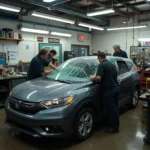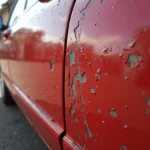A cracked or dented bumper can be an eyesore, and professional repairs can be costly. Luckily, for minor damage, car bumper repair kits offer a convenient and affordable DIY solution. These kits provide everything you need to fix those unsightly blemishes and restore your car’s appearance without breaking the bank.
Understanding Car Bumper Repair Kits
Car bumper repair kits are designed to tackle minor to moderate damage, including:
- Scratches: Superficial scratches that haven’t penetrated the bumper’s plastic.
- Scuffs: Deeper abrasions that have removed some of the bumper’s paint and potentially the plastic underneath.
- Small Dents: Minor indentations in the bumper’s surface.
- Cracks: Hairline or small cracks in the bumper.
It’s important to note that these kits are not a magical fix for all bumper damage. Significant dents, large cracks, or damage that extends to other car parts are best left to professional auto body shops.
Types of Car Bumper Repair Kits
Car bumper repair kits come in various types, each catering to different levels of damage and repair expertise:
1. Basic Repair Kits
Ideal for beginners and minor scratches or scuffs. They typically include:
- Sandpaper: Various grits for smoothing out imperfections.
- Primer: To prepare the surface for painting.
- Touch-up Paint: Often in a small bottle with a brush for convenient application.
- Clear Coat: For a glossy finish and added protection.
Can you repair cracked car bumpers? Find out in our comprehensive guide to cracked bumper repair!
2. Plastic Welding Kits
Designed for repairing cracks and holes in plastic bumpers. They usually come with:
- Plastic Welding Gun: A specialized tool for melting and fusing plastic.
- Plastic Welding Rods: Different types of plastic rods to match your bumper’s material.
- Nozzles: Various nozzle shapes for precise welding.
3. Bumper Filler Kits
Suitable for addressing dents and deeper scratches. These kits include:
- Body Filler: A two-part compound (resin and hardener) that creates a durable, sandable surface.
- Spreader: For applying the filler evenly.
- Hardener: To activate the curing process of the filler.
Knowing the type of damage you’re dealing with will help you choose the right kit for your needs.
What to Consider Before Using a Car Bumper Repair Kit
Before you dive into the repair process, keep these factors in mind:
- Extent of the Damage: Assess the severity of the damage. If it’s extensive or you’re unsure, it’s best to consult a professional.
- Bumper Material: Most modern car bumpers are made from plastic, but older models might have metal bumpers. Make sure you choose a kit compatible with your bumper’s material.
- Color Matching: If your repair involves paint, achieving an exact color match can be tricky. Order touch-up paint from your car’s manufacturer or consult with an auto paint specialist.
- Your DIY Skill Level: Be honest about your DIY abilities. Car bumper repair kits can be user-friendly, but they do require patience and attention to detail.
Car Bumper Repair: A Step-by-Step Guide
While the specific steps might vary slightly depending on the type of kit and damage, here’s a general guide to follow:
- Clean the Area: Thoroughly wash and dry the damaged area. Use a degreaser to remove any dirt, wax, or grease.
- Sand the Surface: Using the appropriate grit sandpaper, sand down the damaged area. If it’s a scratch, sand lightly to roughen the surface for better paint adhesion. For dents or cracks, sand a wider area to create a smooth transition.
- Apply Filler (If Needed): If using a bumper filler kit, mix the filler and hardener as directed. Apply the filler to the dent or crack, spreading it evenly with the spreader. Allow it to dry and harden completely.
- Sand the Filler: Once the filler is dry, sand it down to match the contour of your bumper. Start with a coarser grit sandpaper and gradually move to finer grits for a smooth finish.
- Clean and Mask: Clean the area again to remove any sanding dust. Mask off the surrounding areas to protect them from overspray when painting.
- Prime the Area (If Needed): If the damage exposes bare plastic or metal, apply a coat of primer to promote paint adhesion. Let it dry completely.
- Apply Touch-Up Paint: Shake the touch-up paint bottle well. Apply thin, even coats of paint to the repaired area. Allow each coat to dry completely before applying the next.
- Apply Clear Coat (If Needed): Once the final coat of paint is dry, apply a clear coat for added shine and protection. Follow the drying instructions on the product.
Do you need to fix scratches on your car bumper? Learn how to repair car bumper scuffs effectively with our detailed guide: car bumper sruff repair.
Tips for a Successful Bumper Repair
- Work in a Well-Ventilated Area: Many car repair products emit fumes, so work outdoors or in a well-ventilated garage.
- Wear Protective Gear: Protect yourself by wearing gloves, safety glasses, and a dust mask, especially when sanding or working with chemicals.
- Follow Instructions Carefully: Each car bumper repair kit has specific instructions. Read and follow them closely for best results.
- Be Patient: Rushing the process can lead to mistakes. Allow ample drying time for fillers, primers, and paint.
- Practice Makes Perfect: If you’re new to DIY car repair, consider practicing on a spare bumper or a less visible area of your car first.
Can a plastic car bumper be repaired? Get expert insights into repairing plastic car bumpers in our comprehensive article.
Conclusion
Car bumper repair kits empower car owners to tackle minor damage themselves, saving time and money. By understanding the different types of kits, assessing the damage accurately, and following the instructions carefully, you can achieve professional-looking results and restore your car’s appearance with confidence.
Remember, while these kits are valuable tools for DIY enthusiasts, professional repair is always recommended for significant or complex damage.



